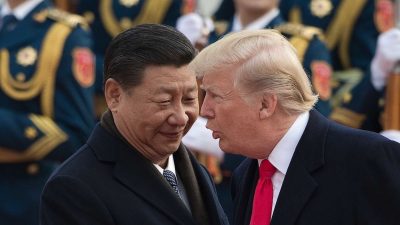China-US Relations: Here’s How China Survived and Thrived During Four Years of Donald Trump
The lesson to be learned is that aggression will always backfire and that cooperation is the only way forward in today's complex world.

The past four years of US President Trump’s time in office were very challenging for China, ye the country managed to not only survive, but even thrive despite the American leader’s best efforts to thwart its rise. It’s important to study how the People’s Republic managed to succeed in spite of all the obstacles that Trump placed in its path. The resultant insight will show the world that China’s leadership accurately understood the elements of the American challenge and accordingly took the most effective measures to counter them.
Chinese-American relations over the past four years are most popular described against the context of Trump’s trade war, which he decided to wage with the intent of crippling what he wrongly believed was the economic foundation of China’s rise. It’s true that bilateral trade played an enormous role in China’s modern-day development over the past four decades, but the country sought to diversify from its erstwhile dependence on this for pragmatic reasons through the Belt & Road Initiative (BRI) that Chinese President Xi unveiled in 2013.
While Trump did make some attempts to obstruct BRI, he focused much more on trying to directly harm the domestic Chinese economy out of the mistaken belief that any externally provoked destabilization thereof through the trade war would catalyze a chain reaction through the global Silk Road network. This was perhaps the most fundamental flaw in his strategy (apart from the obvious one of even waging such an economic war in the first place) because it proves that he completely underestimated the strength of the Silk Roads.
Trump also took a while to realize that China’s economy had diversified quite a lot throughout the past decade and that it was therefore capable of absorbing the artificial shock that the trade war was intended to produce. Once this became unquestionably obvious to him, he tried to expand the trade war into the technological sphere by attempting to curtail the activities of companies such as Huawei, TikTok, and WeChat, albeit to little avail. Those companies are giants in their respective fields and cannot be easily contained.
Again, as the case study of Huawei shows, China had already diversified its economy through the establishment of dozens of new foreign partnerships over the past decade to the point where a system of complex interdependence between the People’s Republic and the rest of the world had already started to take shape. The simple truth is that everyone increasingly needs one another and that only the US and a few of its closest allies are the odd countries left out of this mix due to their increasingly rogue behavior.
As global trends began to suddenly shift in the anti-globalization direction with the onset of the COVID-19 pandemic, Trump was unexpectedly filled with false hope that he might finally dismantle the Silk Roads and their associated supply chains. Alas, this wasn’t meant to be since the Chinese economy recovered earlier than anyone else’s and subsequently became the engine for revitalizing the global economy. Understanding its responsibility to the rest of the world, China unveiled its new development paradigm of dual circulation.
This model more effectively manages globalization processes for everyone by strengthening the complex interdependence between the Chinese economy and the rest of the world. Circulation within the Chinese domestic economy will drive more foreign direct investment into the country, which will in turn stimulate the global economy’s recovery. This isn’t just wishful thinking either but will be actively practiced in the Asia-Pacific after the recent Regional Comprehensive Economic Partnership (RCEP) was agreed to by 15 regional states.
Lo and behold, the US found itself outside of the world’s largest trade bloc, and all because of its own counterproductive policies. By being so obsessed with crippling China’s economy, Trump was blinded to the reality that he was actually crippling America’s own. The US is now ironically just as economically isolated as it hoped that China would be by this time, and it’s no one’s fault but Trump’s. The lesson to be learned is that aggression will always backfire and that cooperation is the only way forward in today’s complex world.
*
Note to readers: please click the share buttons above or below. Forward this article to your email lists. Crosspost on your blog site, internet forums. etc.
This article was originally published on OneWorld.
Andrew Korybko is an American Moscow-based political analyst specializing in the relationship between the US strategy in Afro-Eurasia, China’s One Belt One Road global vision of New Silk Road connectivity, and Hybrid Warfare. He is a frequent contributor to Global Research.
Featured image: Chinese President Xi Jinping and US President Donald Trump in a file image. Image: Youtube

